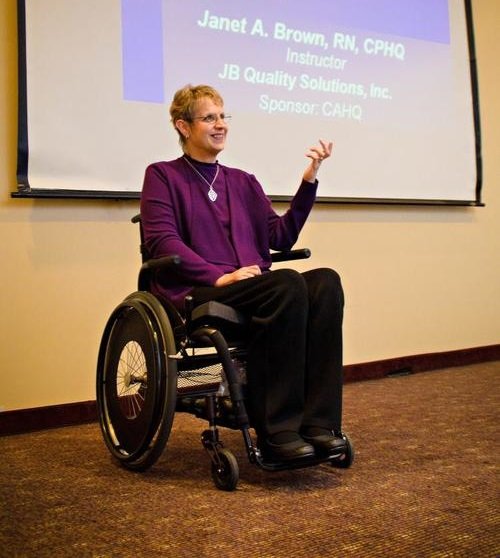
On July 23, 1995, my life changed dramatically. I sustained a spinal cord injury and incomplete quadriplegic in a car accident. I use a wheelchair and have movement of my arms, but limited use of my hands.
I consider the completion of my Handbook to be a miracle. It has continued despite disability, chronic neurogenic pain, and spasticity, multiple computer crashes, and cancer.
I share my cancer story in more detail here because you are quality professionals. In 1996 I was diagnosed with breast cancer. I then experienced local recurrences in 2004 and 2006. I opted for surgery all three times, without chemotherapy (only 2-2.5% improved mortality) or radiation (preempted by the need to preserve my already minimal arm function).
In February 2009, I saw my eighth HMO oncologist (constant contract changes) with symptoms in my right arm. She told me the MRI and PET scan were both negative. Then in December of that year, I was diagnosed with three new tumors, with muscle involvement and nerves at risk. Surgery, radiation, and chemotherapy were not viable options.

Upon directly reviewing all 2009 test results, I learned the previous MRI and PET scans had both shown enhancement. My oncologist had missed the diagnosis months earlier. The cancer center had no electronic record or online access to test results. Their no system allowed physicians to take isolated reports home to call patients, with no access to or requirement to review the medical record. She did not connect the dots between my history, my symptoms, and my test results.
In September 2011 cancer was found metastasized to several bones. In spite of circumstances, my hope and faith is in my Lord.
In my ongoing dealings with two IPAs, four different HMOs, and now Medicare, I have learned first hand—as a patient with the quality professional’s eyes and ears—of our desperate need for a seamless continuum of care, care coordination and case management, electronic record and information sharing, and an effective quality strategy. Even so, I still believe that such a quality healthcare delivery system is achievable!
I cherish the history reflected in these pages, but I thrive on the growth, innovation, and, of course, improvement that represents the current environment and the future of quality in healthcare. Now this quality passion is passed on to you, my colleague. This is a wonderful time for the healthcare quality professional. Both the organization and the public are listening. Your organization will look to your expertise as it seeks to improve. Our patients certainly do deserve—and will benefit from—all of our best efforts.
Janet
Source:
JB Textbook Healthcare Quality, 2016


Dr. Khalid Abulmajd
Healthcare Quality Consultant